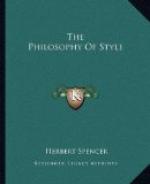“Methought among the lawns together We wandered, underneath the young gray dawn, And multitudes of dense white fleecy clouds Were wandering, in thick flocks along the mountains Shepherded by the slow unwilling wind.”
This last expression is remarkable for the distinctness with which it realizes the features of the scene: bringing the mind, as it were, by a bound to the desired conception.
43. But a limit is put to the advantageous use of the Metaphor, by the condition that it must be sufficiently simple to be understood from a hint. Evidently, if there be any obscurity in the meaning or application of it, no economy of attention will be gained; but rather the reverse. Hence, when the comparison is complex, it is usual to have recourse to the Simile. There is, however, a species of figure, sometimes classed under Allegory, but which might, perhaps, be better called Compound Metaphor, that enables us to retain the brevity of the metaphorical form even where the analogy is intricate. This is done by indicating the application of the figure at the outset, and then leaving the mind to continue the parallel.’ Emerson has employed it with great effect in the first of his I Lectures on the Times’:—“The main interest which any aspects of the Times can have for us is the great spirit which gazes through them, the light which they can shed on the wonderful questions, What are we, and Whither we tend? We do not wish to be deceived. Here we drift, like white sail across the wild ocean, now bright on the wave, now darkling in the trough of the sea; but from what port did we sail? Who knows? Or to what port are we bound? Who knows? There is no one to tell us but such poor weather-tossed mariners as ourselves, whom we speak as we pass, or who have hoisted some signal, or floated to us some letter in a bottle from far. But what know they more than we ? They also found themselves on this wondrous sea. No; from the older sailors nothing. Over all their speaking trumpets the gray sea and the loud winds answer, Not in us; not in Time.”
44. The division of the Simile from the Metaphor is by no means a definite one. Between the one extreme in which the two elements of the comparison are detailed at full length and the analogy pointed out, and the other extreme in which the comparison is implied instead of stated, come intermediate forms, in which the comparison is partly stated and partly implied. For instance:—“Astonished at the performances of the English plow, the Hindoos paint it, set it up, and worship it; thus turning a tool into an idol: linguists do the same with language.” There is an evident advantage in leaving the reader or hearer to complete the figure. And generally these intermediate forms are good in proportion as they do this; provided the mode of completing it be obvious.




